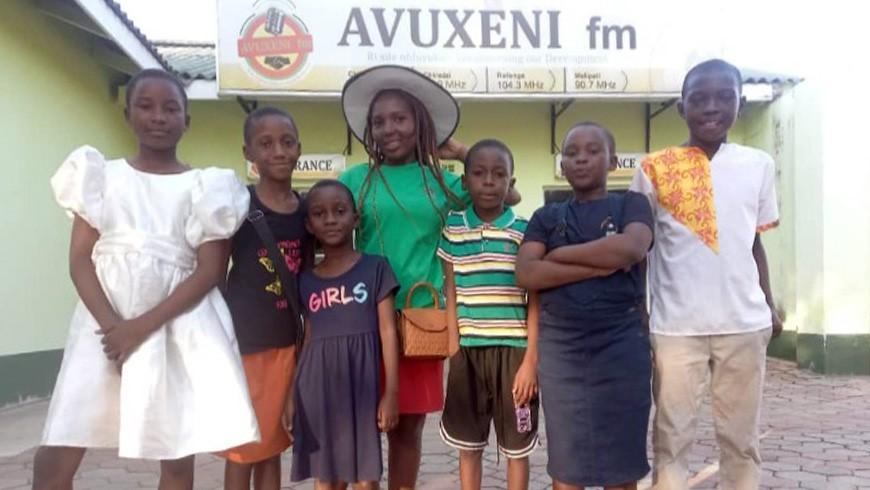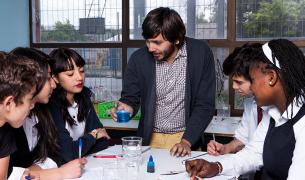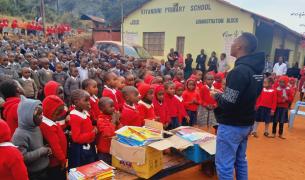From the classroom to the microphone: Taking climate action, one poem, one tree at a time

Climate change used to be just a newspaper headline or scientific term for many living in Zimbabwe. Recently, however, it has become a lived reality. Early in 2025, Chiredzi, a town in South-East Zimbabwe, faced Mother Nature’s wrath when the Chilonga bridge collapsed after the Runde river flooded. The loss of the bridge, which runs between Chiredzi’s township and surrounding villages, cut off motorists and pedestrians from crossing the river, disrupting many livelihoods.
For marginalized teachers and learners, the collapse of the bridge was devastating, and it was just one of the many environmental disasters that have plagued the region in recent years. These days, strong winds blow the roofs from classrooms and prolonged droughts keep girls at home as they fetch water. For those that make it to school, lunch breaks are distressing reminders of food insecurity as they could go without a meal. With smallholder farmers in the area battling armyworm outbreaks that destroy their crops, it is sad to say that for locals, climate change is no longer a foreign concept.
But rather than feel intimidated by these scary changes around us, educators and learners in Chiredzi have responded by finding solutions that work. As a Teach For Zimbabwe fellow, I led a project that creates awareness on climate concerns afflicting the school and the community. To realize these goals, we use the media to create awareness and we created the Conservation Ambassadors, a club that empowers students in climate education.
Climate education thrives on the radio waves
It is usually said that the “revolution will not be televised,” and this might be true. But for me and my students, no one said anything about radio. Every Saturday, at least eight learners visit the studios of Avuxeni FM, a community radio station in Chiredzi, to preach the good gospel of climate action.

For listeners, the radio waves of Avuxeni are a platform for awareness and sensitization as students share what they learn in the classroom and in their clubs. As the leaders of today and tomorrow, the students passionately champion the climate revolution, and for one hour every Saturday, they share their poems, songs, and stories about the climate. On these shows, they recite what they have learned in languages that can be understood by people of all ages.
“The forest, the oceans, the mountains so high, so let’s cherish and let’s protect them,
The trees stand tall with a wisdom in its mind, a beauty of nature’s sight,
The rivers flow gently with a soothing sound, let’s protect the one who gives us life and makes our spirits sing,
Let’s reduce, reuse, and protect for the future of our planet.”
(Poem by Princess, a Grade 5 learner)
For learners, the radio station has become an opportunity to build soft skills such as confidence and eloquence. But as an added element, they get to learn and teach others about important topics, generating both reach and impact.
While climate education is not yet part of the curriculum in Zimbabwe, educators like me have found ways of including it in various lessons. For example, in my Heritage Studies classes, we co-create lessons that are meaningful and engaging by exploring everyday topics with links to climate. I help learners understand destructive behaviours such as illegal deforestation, pollution, and improper waste management, in ways that relate to their lives. Since my desire has always been to build student understanding of environmental and climate challenges, I have structured my lessons to build awareness and inspire agency.
Student-led projects are bearing fruit
The impact of integrating climate education into my teaching has been the birth of the Conservation Ambassadors as champions of change in their communities. Within the project and outside, the learners have planted over 2,000 fruit trees and learned the craft of grafting trees. They have adopted these farming skills and transferred them to their homes where they challenge their families to turn seeds into strong plants that can bear more fruit.
Sharing our club activities on the radio has helped us to attract local partnerships with various entities such as the Environmental Management Agency (EMA) and the Forestry Commission. The community has been a core partner in all our activities and have helped shape our activities to be context specific. Championing the protection of indigenous trees and forests, for example, was a clear call from the community. Community elders have also engaged learners to remember traditional practices that helped protect the environment.
Challenges exist, but we can conquer them together
As a second-year fellow, I must note that the journey has been rewarding, with its own set of triumphs and challenges. Some concerns we have faced include low learner retention when students lack the money required to travel to the radio station or tree planting events. Most times, our main funders are parents and when they are struggling, learners lack the opportunity to show up for events where they can create a difference. Sometimes, I take it upon myself to support passionate learners, but I can only do so much.
At other times, our projects face resistance from partners who fail to understand our goals and aspirations since climate change is not yet acknowledged as a serious issue. Our leaders do not budget for it, and this limits real progress on the ground. Still, the future is bright, and I foresee more gains when we can secure more partnerships and funding.
For educators wondering how to implement climate education in their context, I challenge you to just start. Learn alongside your learners and find a community of peers. For me, the Teach For Zimbabwe community and the Teach For All climate education champions community of fellows and alumni implementing climate education has been pivotal for my journey. Find a community and find collaborators to work together with on the ground.



